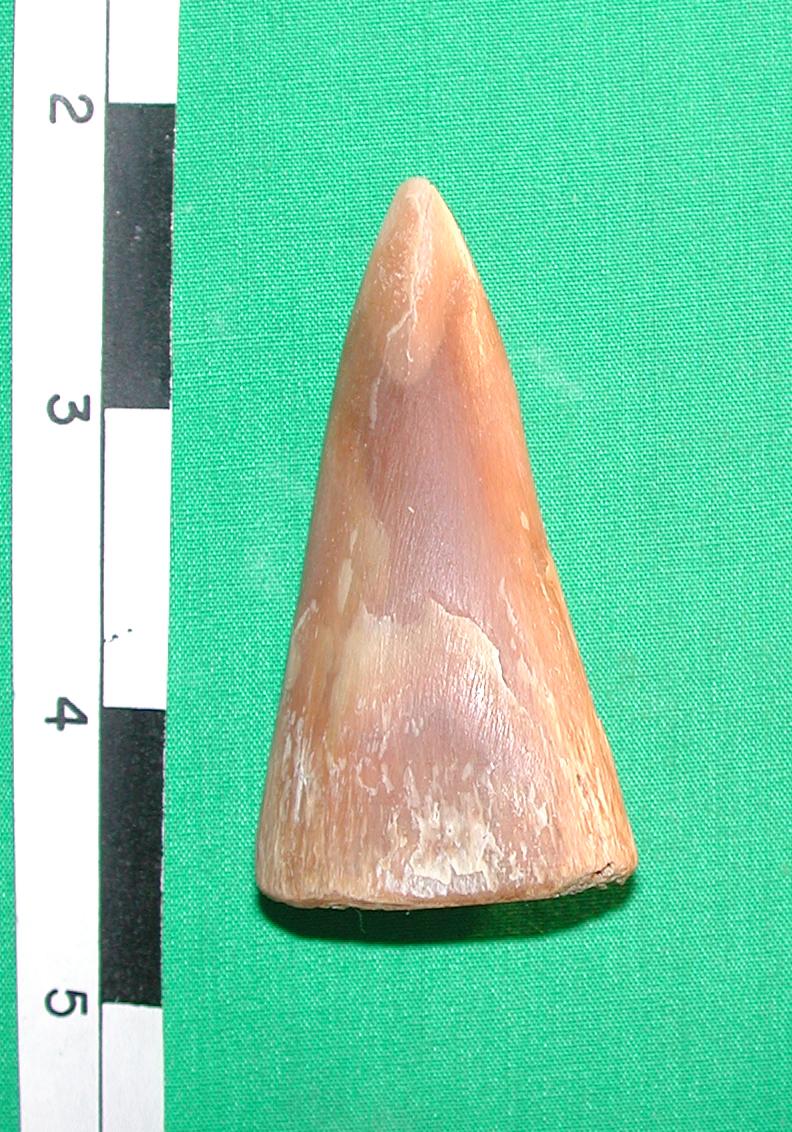




Judging from late Woodland and Mississippian Caddoan sites, Perino suggested the origin of antler faunal socketed arrow points (1-2) and bone socketed points (3-5)to be about A.D. 600 and that their use continued into Historic times, corresponding with the use of the bow. Bone points made from alligator toe bones will have an orifice at the tip end where the claw protruded from the bone. Arrow points of this type have a distinctly smaller bore than dart points, measuring about 3/8 inch in diameter. The bore of a dart points can measure 1/2 inch in diameter. Arrow points normally measure about 2-3 cm in length while dart points can measure 3 or more inches in length.
This point type, while rare throughout the Southeast, was recovered in significant numbers by private collectors at the Tick Island site. A cache of antler tine points was recovered from level 3 of burial BK9 at the Lake Jackson Mound site near Tallahassee, Florida, suggesting use by Fort Walton people. Other recoveries might be expected in areas where bone was heavily used. We may never know just how heavily bone and antler materials were used, but I suspect, based on antler remains at Mt. Royal and other sites, that it accounted for a large portion of the total point material.
The name is generic and relates to atlatl dart tips made from the hollowed out tine of a deer antler. Gregory Perino reported these, noting examples from Kentucky and Tennessee.
Antler dart tips can measure from 2 to 5 inches in length and are considerably larger than those presumably used as arrow points in later periods. The dart tip was produced in one of three ways. These were made by cutting the antler tine off at an angle producing one barb, or by cutting of the tine flat and grinding the center to a concave shape producing a double barb, or finally by leaving the basal edge flat to fit the end of the dart shaft. Occasionally the distal end of the point was honed to a symmetrical conical shape in line with the drilled hole. These artifacts are predominately a phenomenon of the eastern United States.
Socketed bone points are very numerous and are typically found on sites containing other types of bone points or in river contexts. These points are generally rather short measuring 2 to 3 inches in length and .75 inches across the base. The distal end is shaped to reveal the internal channel of the bone. The base is often formed at a bone joint. Some well-worked examples appear very symmetrical with a concave base. Given their period of heaviest use, these probably served as dart points.
These bone pins or points are made from the foreleg of a deer. The bone has a natural channel along one side. A groove was cut down the opposite side and the bone could be snapped in half lengthwise. Each half was then grooved and split, producing four pins or points. The center channel is clearly seen on each point. One or both ends of the point could then be honed to a sharp tip for use with an atlatl dart. Bone points of this type may range from 3 to 6 inches or more. Bone points from the Paleoindian period, made in this same way but measuring between 8 and 10 inches, have been recovered by the hundreds in the context of mastodon or mammoth kill sites. Early diver Ben Waller suggested that the high number of bone points may indicate a method of killing through ingestion with grasses prepared by hunters for this purpose, or they may have been used to hold back the heavy hides of the animals during the butchering process. Care should be taken not to confuse these with hair pins (covered with bone and decorative items). Hair pins are rounded and will not display the center channel. They are also often intricately decorated.
Single and multiple notched harpoon tips were made in this same way. Some examples were rounded while most were flattened. Very few examples of composite bone harpoons have been recovered like this one from the Oklawaha River in Florida. A slot was cut in the long bone pin and a second short “blade” was inserted into the bone and held in place with pitch.

Points that are carved from bone are rare. This replica of a carved point from Volutia Counta, Florida is an illustration of such points. Four points were found in a shell midden. The forms included stemmed and side-notched points.